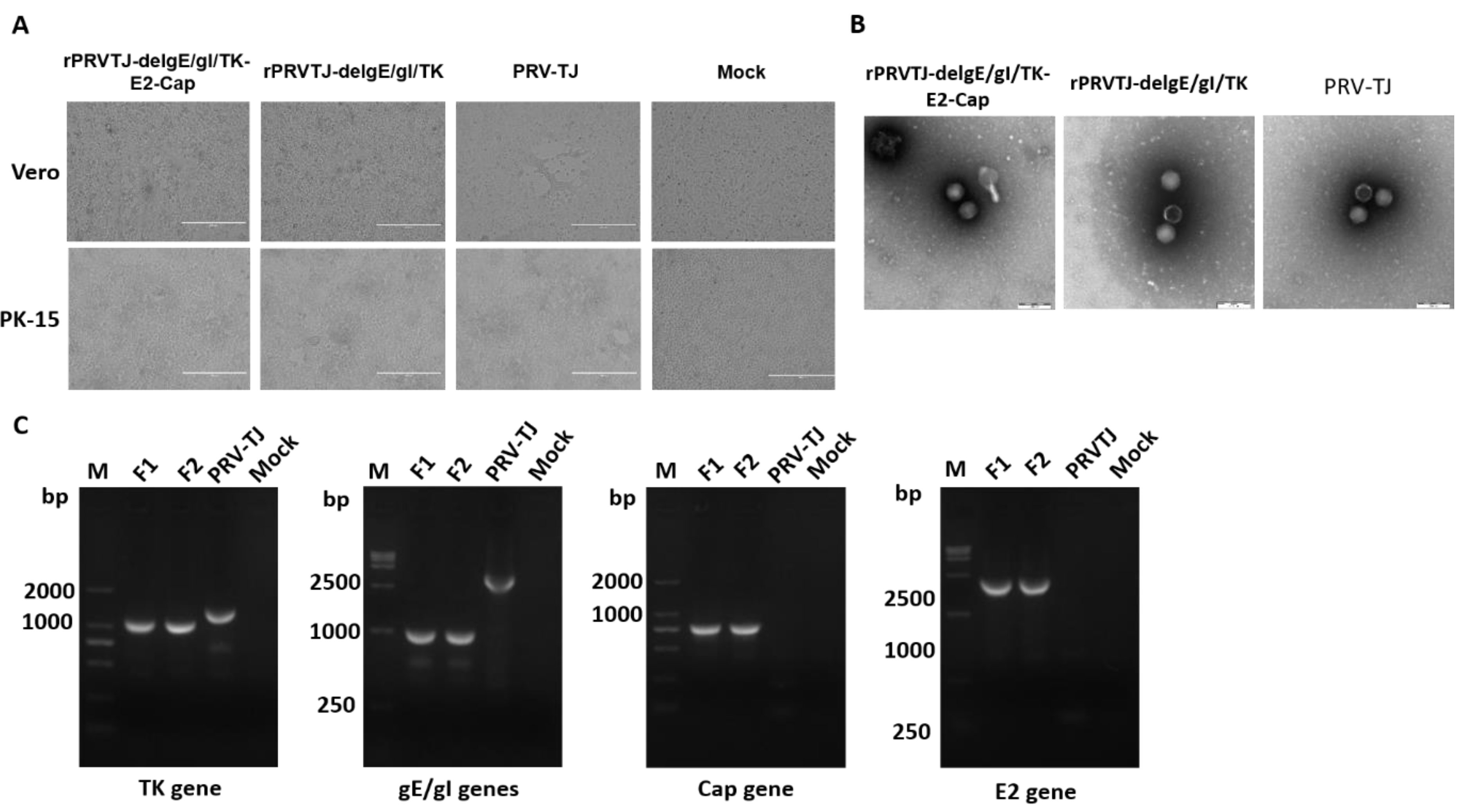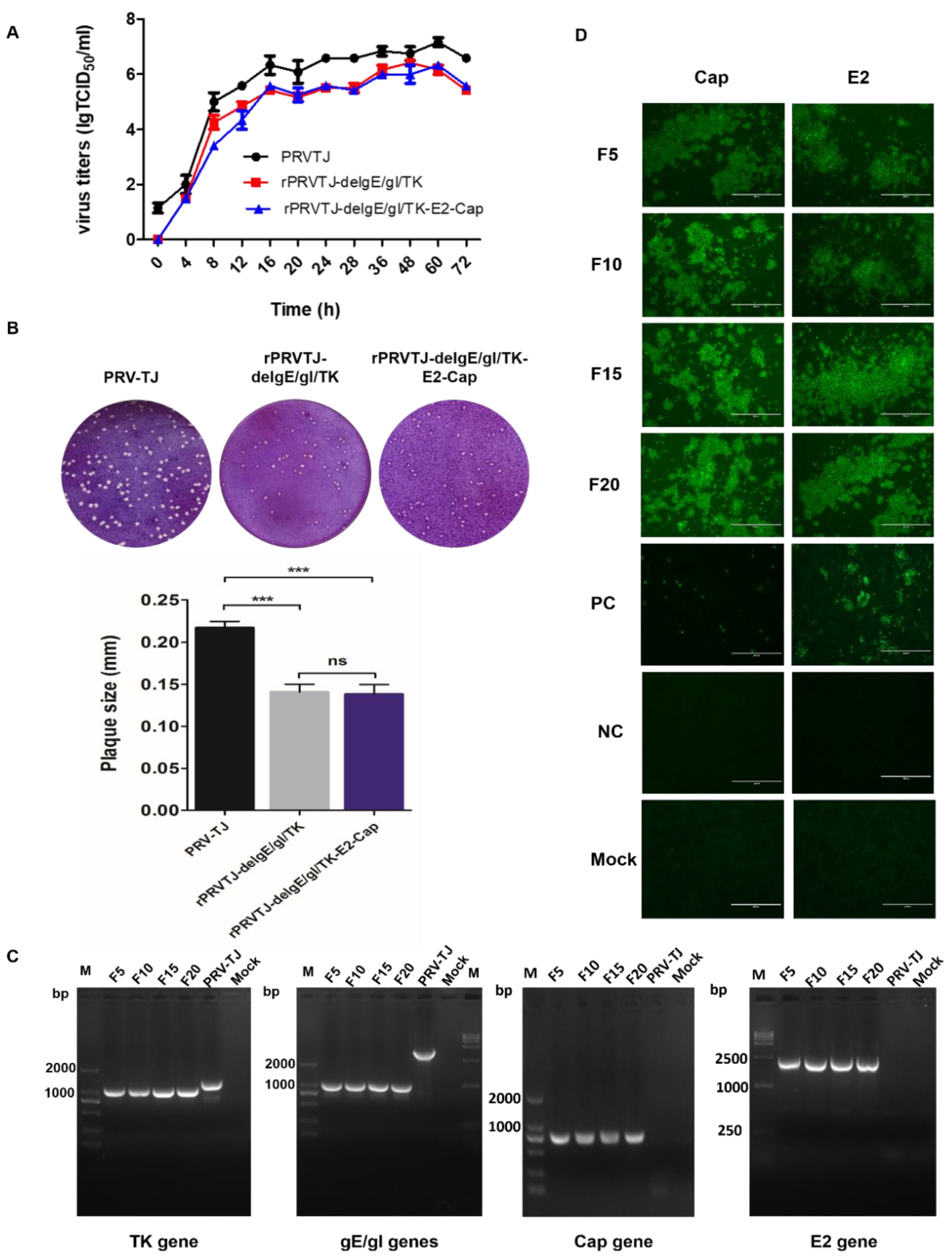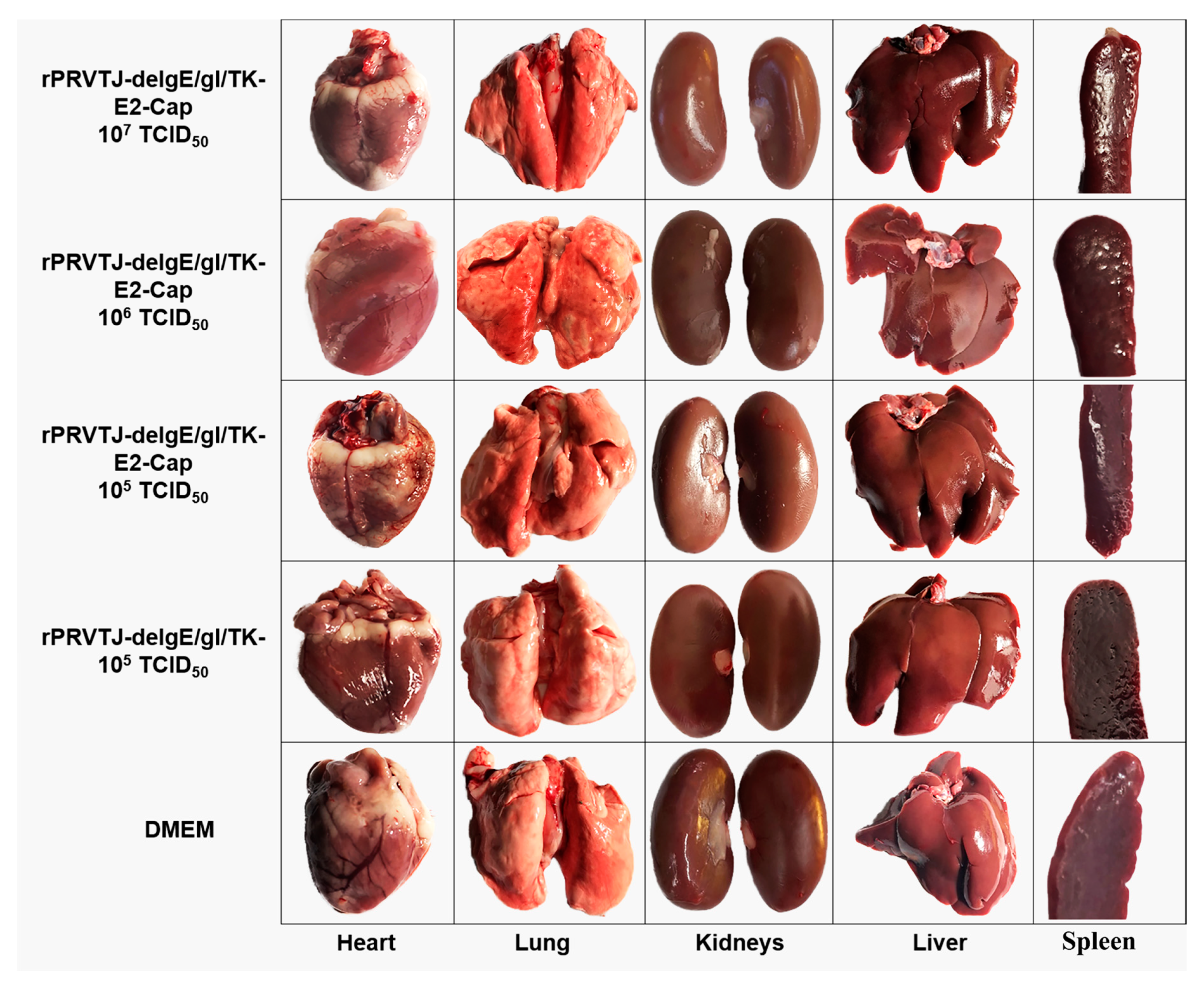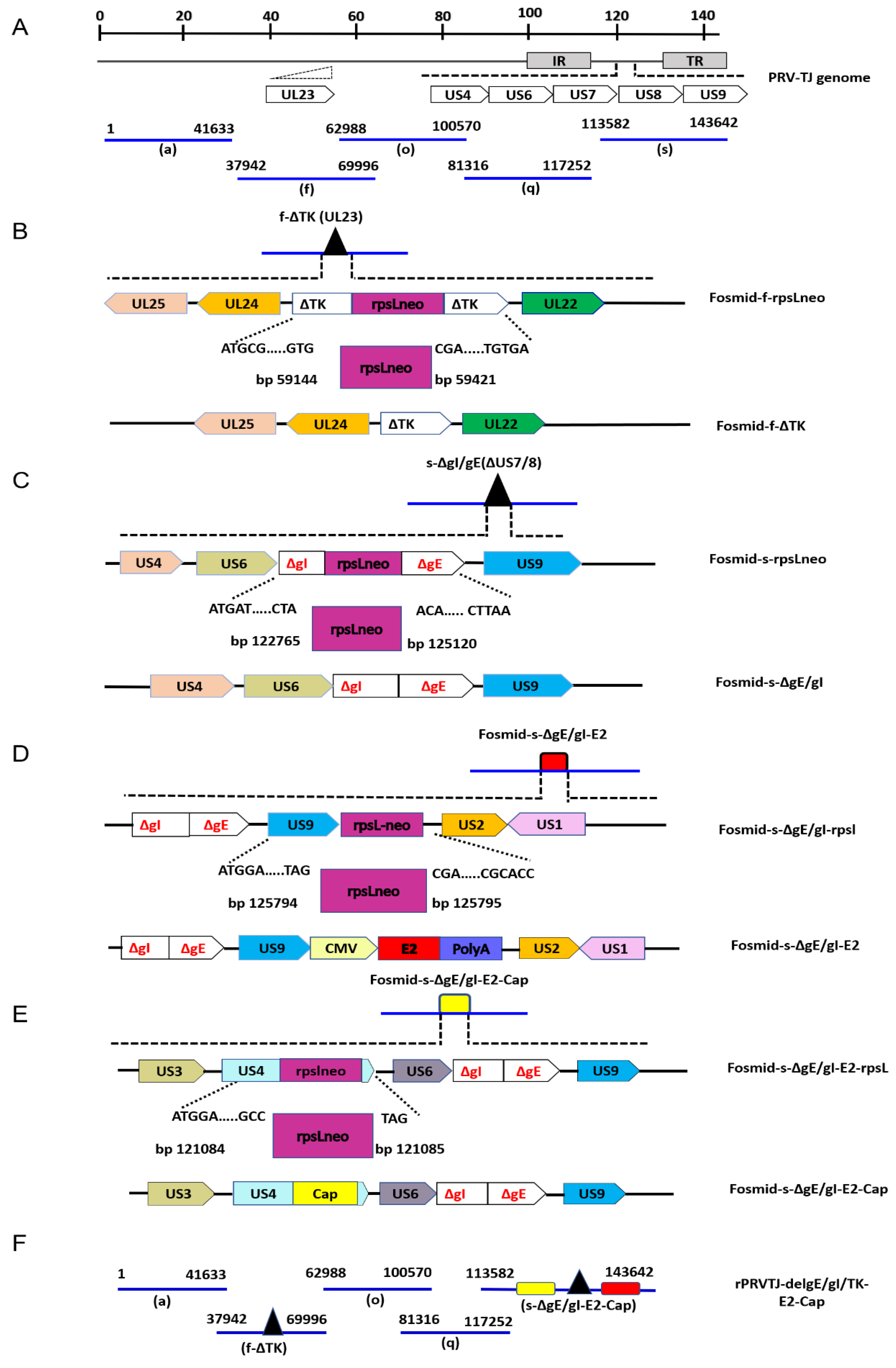Generation and Immunogenicity of a Recombinant Pseudorabies Virus Co-Expressing Classical Swine Fever Virus E2 Protein and Porcine Circovirus Type 2 Capsid Protein Based on Fosmid Library Platform
Abstract
1. Introduction
2. Results
2.1. Rescue and Characterization of rPRVTJ-delgE/gI/TK-E2-Cap
2.2. Confirmation of E2 and Cap Expression
2.3. Growth Kinetics and Stability of Recombinant Viruses
2.4. Safety of rPRVTJ-delgE/gI/TK-E2-Cap for Rabbits
2.5. Immunogenicity of rPRVTJ-delgE/gI/TK-E2-Cap in Rabbits and Pigs
3. Discussion
4. Materials and Methods
4.1. Virus and Cells
4.2. Construction of Recombinant Fosmids with TK and gE/gI Gene-Deletion
4.3. Construction of Recombinant E2 Expression Cassette
4.4. Construction of Recombinant Fosmid with E2 and Cap Gene Insertion
4.5. Rescue and Dentification of rPRVTJ-delgE/gI/TK-E2-Cap
4.6. Immunofluorescence Assay (IFA) and Western Blotting
4.7. Growth Properties and Genetic Stability of the Recombinant Virus
4.8. Safety and Immunogenicity Evaluation in Rabbits and Pigs
4.9. Blocking ELISA
4.10. Statistical Analysis
Author Contributions
Funding
Acknowledgments
Conflicts of Interest
References
- Mettenleiter, T.C. Aujeszky’s disease (pseudorabies) virus: The virus and molecular pathogenesis-state of the art, June 1999. Vet. Res. 2000, 31, 99–115. [Google Scholar] [CrossRef] [PubMed]
- Pomeranz, L.E.; Reynolds, A.E.; Hengartner, C.J. Molecular biology of pseudorabies virus: Impact on neurovirology and veterinary medicine. Microbiol. Mol. Biol. Rev. 2005, 69, 462–500. [Google Scholar] [CrossRef] [PubMed]
- An, T.Q.; Peng, J.M.; Tian, Z.J.; Zhao, H.Y.; Li, N.; Liu, Y.M.; Chen, J.Z.; Leng, C.L.; Sun, Y.; Chang, D. Pseudorabies virus variant in Bartha-K61–vaccinated pigs, china, 2012. Emerg. Infect. Dis. 2013, 19, 1749. [Google Scholar] [CrossRef] [PubMed]
- Freuling, C.; Müller, T.; Mettenleiter, T. Vaccines against pseudorabies virus (PrV). Vet. Microbiol. 2017, 206, 3–9. [Google Scholar] [CrossRef] [PubMed]
- Chen, Y.; Guo, W.; Xu, Z.; Yan, Q.; Luo, Y.; Shi, Q.; Chen, D.; Zhu, L.; Wang, X. A novel recombinant pseudorabies virus expressing parvovirus VP2 gene: Immunogenicity and protective efficacy in swine. Virol. J. 2011, 8, 307. [Google Scholar] [CrossRef] [PubMed]
- Wang, C.H.; Yuan, J.; Qin, H.Y.; Luo, Y.; Cong, X.; Li, Y.; Chen, J.; Li, S.; Sun, Y.; Qiu, H.J. A novel gE-deleted pseudorabies virus (PRV) provides rapid and complete protection from lethal challenge with the PRV variant emerging in Bartha-K61-vaccinated swine population in China. Vaccine 2014, 32, 3379–3385. [Google Scholar] [CrossRef] [PubMed]
- Cong, X.; Lei, J.L.; Xia, S.L.; Wang, Y.M.; Li, Y.; Li, S.; Luo, Y.; Sun, Y.; Qiu, H.J. Pathogenicity and immunogenicity of a gE/gI/TK gene–deleted pseudorabies virus variant in susceptible animals. Vet. Microbiol. 2016, 182, 170–177. [Google Scholar] [CrossRef] [PubMed]
- Moennig, V.; Floegel-Niesmann, G.; Greiser-Wilke, I. Clinical signs and epidemiology of classical swine fever: A review of new knowledge. Vet. J. 2003, 165, 11–20. [Google Scholar] [CrossRef]
- Edwards, S.; Fukusho, A.; Lefevre, P.C.; Lipowski, A.; Pejsak, Z.; Roehe, P.; Westergaard, J. Classical swine fever: The global situation. Vet. Microbiol. 2000, 73, 103–119. [Google Scholar] [CrossRef]
- Blome, S.; Moß, C.; Reimann, I.; König, P.; Beer, M. Classical swine fever vaccines—State-of-the-art. Vet. Microbiol. 2017, 206, 10–20. [Google Scholar] [CrossRef] [PubMed]
- Weiland, F.; Weiland, E.; Unger, G.; Saalm, A.; Thiel, H. Localization of pestiviral envelope proteins E (rns) and E2 at the cell surface and on isolated particles. J. Gen. Virol. 1999, 80, 1157–1165. [Google Scholar] [CrossRef] [PubMed]
- van Rijn, P.; Bossers, A.; Wensvoort, G.; Moormann, R. Classical swine fever virus (CSFV) envelope glycoprotein E2 containing one structural antigenic unit protects pigs from lethal CSFV challenge. J. Gen. Virol. 1996, 77, 2737–2745. [Google Scholar] [CrossRef] [PubMed]
- Bouma, A.; de Smit, A.; de Kluijver, E.; Terpstra, C.; Moormann, R. Efficacy and stability of a subunit vaccine based on glycoprotein E2 of classical swine fever virus. Vet. Microbiol. 1999, 66, 101–114. [Google Scholar] [CrossRef]
- Blome, S.; Staubach, C.; Henke, J.; Carlson, J.; Beer, M. Classical swine fever—An updated review. Viruses 2017, 9, 86. [Google Scholar] [CrossRef] [PubMed]
- van Rijn, P. A common neutralizing epitope on envelope glycoprotein E2 of different pestiviruses: Implications for improvement of vaccines and diagnostics for classical swine fever (CSF)? Vet. Microbiol. 2007, 125, 150–156. [Google Scholar] [CrossRef] [PubMed]
- Dong, X.N.; Chen, Y.H. Marker vaccine strategies and candidate CSFV marker vaccines. Vaccine 2007, 25, 205–230. [Google Scholar] [CrossRef] [PubMed]
- Allan, G.M.; Ellis, J.A. Porcine circoviruses: A review. J. Vet. Diagn. Investig. 2000, 12, 3–14. [Google Scholar] [CrossRef] [PubMed]
- Opriessnig, T.; Meng, X.J.; Halbur, P.G. Porcine circovirus type 2–associated disease: Update on current terminology, clinical manifestations, pathogenesis, diagnosis, and intervention strategies. J. Vet. Diagn. Investig. 2007, 19, 591–615. [Google Scholar] [CrossRef] [PubMed]
- Rovira, A.; Balasch, M.; Segalés, J.; Garcia, L.; Plana-Duran, J.; Rosell, C.; Ellerbrok, H.; Mankertz, A.; Domingo, M. Experimental inoculation of conventional pigs with porcine reproductive and respiratory syndrome virus and porcine circovirus 2. J. Virol. 2002, 76, 3232–3239. [Google Scholar] [CrossRef] [PubMed]
- Allan, G.; Kennedy, S.; McNeilly, F.; Foster, J.; Ellis, J.; Krakowka, S.; Meehan, B.; Adair, B. Experimental reproduction of severe wasting disease by co-infection of pigs with porcine circovirus and porcine parvovirus. J. Comp. Pathol. 1999, 121, 1–11. [Google Scholar] [CrossRef] [PubMed]
- Truong, C.; Mahé, D.; Blanchard, P.; Le Dimna, M.; Madec, F.; Jestin, A.; Albina, E. Identification of an immunorelevant ORF2 epitope from porcine circovirus type 2 as a serological marker for experimental and natural infection. Arch. Virol. 2001, 146, 1197–1211. [Google Scholar] [CrossRef] [PubMed]
- Wu, P.C.; Lin, W.L.; Wu, C.-M.; Chi, J.N.; Chien, M.-S.; Huang, C. Characterization of porcine circovirus type 2 (PCV2) capsid particle assembly and its application to virus-like particle vaccine development. Appl. Microbiol. Biotechnol. 2012, 95, 1501–1507. [Google Scholar] [CrossRef] [PubMed]
- Liu, L.-J.; Suzuki, T.; Tsunemitsu, H.; Kataoka, M.; Ngata, N.; Takeda, N.; Wakita, T.; Miyamura, T.; Li, T.-C. Efficient production of type 2 porcine circovirus-like particles by a recombinant baculovirus. Arch. Virol. 2008, 153, 2291. [Google Scholar] [CrossRef] [PubMed]
- Chae, C. Commercial porcine circovirus type 2 vaccines: Efficacy and clinical application. Vet. J. 2012, 194, 151–157. [Google Scholar] [CrossRef] [PubMed]
- Martelli, P.; Ferrari, L.; Morganti, M.; de Angelis, E.; Bonilauri, P.; Guazzetti, S.; Caleffi, A.; Borghetti, P. One dose of a porcine circovirus 2 subunit vaccine induces humoral and cell-mediated immunity and protects against porcine circovirus-associated disease under field conditions. Vet. Microbiol. 2011, 149, 339–351. [Google Scholar] [CrossRef] [PubMed]
- Alarcon, P.; Rushton, J.; Wieland, B. Cost of post-weaning multi-systemic wasting syndrome and porcine circovirus type-2 subclinical infection in England—An economic disease model. Prev. Vet. Med. 2013, 110, 88–102. [Google Scholar] [CrossRef] [PubMed]
- Opriessnig, T.; Gerber, P.F.; Xiao, C.T.; Halbur, P.G.; Matzinger, S.R.; Meng, X.J. Commercial PCV2a-based vaccines are effective in protecting naturally PCV2b-infected finisher pigs against experimental challenge with a 2012 mutant PCV2. Vaccine 2014, 32, 4342–4348. [Google Scholar] [CrossRef] [PubMed]
- Segalés, J. Best practice and future challenges for vaccination against porcine circovirus type 2. Expert Rev. Vaccines 2015, 14, 473–487. [Google Scholar] [CrossRef] [PubMed]
- Kekarainen, T.; McCullough, K.; Fort, M.; Fossum, C.; Segalés, J.; Allan, G. Immune responses and vaccine-induced immunity against Porcine circovirus type 2. Vet. Immunol. Immunopathol. 2010, 136, 185–193. [Google Scholar] [CrossRef] [PubMed]
- Firth, C.; Charleston, M.A.; Duffy, S.; Shapiro, B.; Holmes, E.C. Insights into the evolutionary history of an emerging livestock pathogen: Porcine circovirus 2. J. Virol. 2009, 83, 12813–12821. [Google Scholar] [CrossRef] [PubMed]
- Kekarainen, T.; Gonzalez, A.; Llorens, A.; Segales, J. Genetic variability of porcine circovirus 2 in vaccinating and non-vaccinating commercial farms. J. Gen. Virol. 2014, 95, 1734–1742. [Google Scholar] [CrossRef] [PubMed]
- Reiner, G.; Hofmeister, R.; Willems, H. Genetic variability of porcine circovirus 2 (PCV2) field isolates from vaccinated and non-vaccinated pig herds in Germany. Vet. Microbiol. 2015, 180, 41–48. [Google Scholar] [CrossRef] [PubMed]
- Lei, J.L.; Xia, S.L.; Wang, Y.; Du, M.; Xiang, G.T.; Cong, X.; Luo, Y.; Li, L.F.; Zhang, L.; Yu, J. Safety and immunogenicity of a gE/gI/TK gene-deleted pseudorabies virus variant expressing the E2 protein of classical swine fever virus in pigs. Immunol. Lett. 2016, 174, 63–71. [Google Scholar] [CrossRef] [PubMed]
- Beach, N.M.; Meng, X.J. Efficacy and future prospects of commercially available and experimental vaccines against porcine circovirus type 2 (PCV2). Virus Res. 2012, 164, 33–42. [Google Scholar] [CrossRef] [PubMed]
- Huang, Y.L.; Pang, V.F.; Lin, C.M.; Tsai, Y.C.; Chia, M.-Y.; Deng, M.C.; Chang, C.Y.; Jeng, C.R. Porcine circovirus type 2 (PCV2) infection decreases the efficacy of an attenuated classical swine fever virus (CSFV) vaccine. Vet. Res. 2011, 42, 115. [Google Scholar] [CrossRef] [PubMed]
- Zhang, L.; Li, Y.; Xie, L.; Wang, X.; Gao, X.; Sun, Y.; Qiu, H.J. Secreted expression of the Cap gene of porcine circovirus type 2 in classical swine fever virus C-strain: potential of C-strain used as a vaccine vector. Viruses 2017, 9, 298. [Google Scholar] [CrossRef] [PubMed]
- van Iddekinge, B.H.; de Wind, N.; Wensvoort, G.; Kimman, T.; Gielkens, A.; Moormann, R. Comparison of the protective efficacy of recombinant pseudorabies viruses against pseudorabies and classical swine fever in pigs; influence of different promoters on gene expression and on protection. Vaccine 1996, 14, 6–12. [Google Scholar] [CrossRef]
- Qiu, H.J.; Tian, Z.J.; Tong, G.Z.; Zhou, Y.J.; Ni, J.Q.; Luo, Y.Z.; Cai, X.H. Protective immunity induced by a recombinant pseudorabies virus expressing the GP5 of porcine reproductive and respiratory syndrome virus in piglets. Vet. Immunol. Immunopathol. 2005, 106, 309–319. [Google Scholar] [CrossRef] [PubMed]
- Qian, P.; Li, X.M.; Jin, M.L.; Peng, G.Q.; Chen, H.C. An approach to a FMD vaccine based on genetic engineered attenuated pseudorabies virus: One experiment using VP1 gene alone generates an antibody responds on FMD and pseudorabies in swine. Vaccine 2004, 22, 2129–2136. [Google Scholar] [CrossRef] [PubMed]
- Jiang, Y.; Fang, L.; Xiao, S.; Zhang, H.; Pan, Y.; Luo, R.; Li, B.; Chen, H. Immunogenicity and protective efficacy of recombinant pseudorabies virus expressing the two major membrane-associated proteins of porcine reproductive and respiratory syndrome virus. Vaccine 2007, 25, 547–560. [Google Scholar] [CrossRef] [PubMed]
- Hong, Q.; Qian, P.; Li, X.M.; Yu, X.L.; Chen, H.C. A recombinant pseudorabies virus co-expressing capsid proteins precursor P1-2A of FMDV and VP2 protein of porcine parvovirus: A trivalent vaccine candidate. Biotechnol. Lett. 2007, 29, 1677–1683. [Google Scholar] [CrossRef] [PubMed]
- Song, Y.; Jin, M.; Zhang, S.; Xu, X.; Xiao, S.; Cao, S.; Chen, H. Generation and immunogenicity of a recombinant pseudorabies virus expressing cap protein of porcine circovirus type 2. Vet. Microbiol. 2007, 119, 97–104. [Google Scholar] [CrossRef] [PubMed]
- He, Y.; Qian, P.; Zhang, K.; Yao, Q.; Wang, D.; Xu, Z.; Wu, B.; Jin, M.; Xiao, S.; Chen, H. Construction and immune response characterization of a recombinant pseudorabies virus co-expressing capsid precursor protein (P1) and a multiepitope peptide of foot-and-mouth disease virus in swine. Virus Gene. 2008, 36, 393–400. [Google Scholar] [CrossRef] [PubMed]
- Tobler, K.; Fraefel, C. Infectious delivery of alphaherpesvirus bacterial artificial chromosomes. In Bacterial Artificial Chromosomes; Springer: Berlin/Heidelberg, Germany, 2015; pp. 217–230. Available online: https://link.springer.com/protocol/10.1007/978-1-4939-1652-8_10 (accessed on 29 March 2019).
- Close, W.L.; Bhandari, A.; Hojeij, M.; Pellett, P.E. Generation of a novel human cytomegalovirus bacterial artificial chromosome tailored for transduction of exogenous sequences. Virus Res. 2017, 242, 66–78. [Google Scholar] [CrossRef] [PubMed]
- Zhao, Y.; Petherbridge, L.; Smith, L.P.; Baigent, S.; Nair, V. Self-excision of the BAC sequences from the recombinant Marek’s disease virus genome increases replication and pathogenicity. Virol. J. 2008, 5, 19. [Google Scholar] [CrossRef] [PubMed]
- Zhou, F.; Li, Q.; Wong, S.W.; Gao, S.J. Autoexcision of bacterial artificial chromosome facilitated by terminal repeat-mediated homologous recombination: A novel approach for generating traceless genetic mutants of herpesviruses. J. Virol. 2010, 84, 2871–2880. [Google Scholar] [CrossRef] [PubMed]
- Liu, Y.; Li, K.; Gao, Y.; Gao, L.; Zhong, L.; Zhang, Y.; Liu, C.; Zhang, Y.; Wang, X. Recombinant Marek’s disease virus as a vector-based vaccine against avian leukosis virus subgroup J in chicken. Viruses 2016, 8, 301. [Google Scholar] [CrossRef] [PubMed]
- Li, K.; Liu, Y.; Liu, C.; Gao, L.; Zhang, Y.; Cui, H.; Gao, Y.; Qi, X.; Zhong, L.; Wang, X. Recombinant Marek’s disease virus type 1 provides full protection against very virulent Marek’s and infectious bursal disease viruses in chickens. Sci. Rep. 2016, 6, 39263. [Google Scholar] [CrossRef] [PubMed]
- Peeters, B.; Bienkowska-Szewczyk, K.; Hulst, M.; Gielkens, A.; Kimman, T. Biologically safe, non-transmissible pseudorabies virus vector vaccine protects pigs against both Aujeszky’s disease and classical swine fever. J. Gen. Virol. 1997, 78, 3311–3315. [Google Scholar] [CrossRef] [PubMed]
- Swenson, S.L.; McMillen, J.; Hill, H.T. Evaluation of the safety and efficacy of a thymidine kinase, inverted repeat, gI, and gpX gene-deleted pseudorabies vaccine. J. Vet. Diagn. Investig. 1993, 5, 341–346. [Google Scholar] [CrossRef] [PubMed]
- Souza, A.; Haut, L.; Reyes-Sandoval, A.; Pinto, A. Recombinant viruses as vaccines against viral diseases. Braz. J. Med. Biol. Res. 2005, 38, 509–522. [Google Scholar] [CrossRef] [PubMed]
- Wang, Y.; Yuan, J.; Cong, X.; Qin, H.Y.; Wang, C.H.; Li, Y.; Li, S.; Luo, Y.; Sun, Y.; Qiu, H.J. Generation and efficacy evaluation of a recombinant pseudorabies virus variant expressing the E2 protein of classical swine fever virus in pigs. Clin. Vaccine Immunol. 2015, 22, 1121–1129. [Google Scholar] [CrossRef] [PubMed]
- Ganges, L.; Barrera, M.; Núñez, J.I.; Blanco, I.; Frias, M.T.; Rodríguez, F.; Sobrino, F. A DNA vaccine expressing the E2 protein of classical swine fever virus elicits T cell responses that can prime for rapid antibody production and confer total protection upon viral challenge. Vaccine 2005, 23, 3741–3752. [Google Scholar] [CrossRef] [PubMed]
- Blome, S.; Aebischer, A.; Lange, E.; Hofmann, M.; Leifer, I.; Loeffen, W.; Koenen, F.; Beer, M. Comparative evaluation of live marker vaccine candidates “CP7_E2alf” and “flc11” along with C-strain “Riems” after oral vaccination. Vet. Microbiol. 2012, 158, 42–59. [Google Scholar] [CrossRef] [PubMed]
- Sun, Y.; Liu, D.F.; Wang, Y.F.; Liang, B.B.; Cheng, D.; Li, N.; Qi, Q.F.; Zhu, Q.H.; Qiu, H.J. Generation and efficacy evaluation of a recombinant adenovirus expressing the E2 protein of classical swine fever virus. Res. Vet. Sci. 2010, 88, 77–82. [Google Scholar] [CrossRef] [PubMed]
- Tarradas, J.; Monsó, M.; Muñoz, M.; Rosell, R.; Fraile, L.; Frías, M.T.; Domingo, M.; Andreu, D.; Sobrino, F.; Ganges, L. Partial protection against classical swine fever virus elicited by dendrimeric vaccine-candidate peptides in domestic pigs. Vaccine 2011, 29, 4422–4429. [Google Scholar] [CrossRef] [PubMed]
- Walsh, E.P.; Baron, M.D.; Anderson, J.; Barrett, T. Development of a genetically marked recombinant rinderpest vaccine expressing green fluorescent protein. J. Gen. Virol. 2000, 81, 709–718. [Google Scholar] [CrossRef] [PubMed]
- Thomson, S.A.; Burrows, S.R.; Misko, I.S.; Moss, D.J.; Coupar, B.E.; Khanna, R. Targeting a polyepitope protein incorporating multiple class II-restricted viral epitopes to the secretory/endocytic pathway facilitates immune recognition by CD4+ cytotoxic T lymphocytes: A novel approach to vaccine design. J. Virol. 1998, 72, 2246–2252. [Google Scholar] [PubMed]
- Walsh, E.P.; Baron, M.D.; Rennie, L.F.; Monaghan, P.; Anderson, J.; Barrett, T. Recombinant rinderpest vaccines expressing membrane-anchored proteins as genetic markers: Evidence of exclusion of marker protein from the virus envelope. J. Virol. 2000, 74, 10165–10175. [Google Scholar] [CrossRef] [PubMed]
- Luo, Y.; Li, N.; Cong, X.; Wang, C.H.; Du, M.; Li, L.; Zhao, B.; Yuan, J.; Liu, D.D.; Li, S. Pathogenicity and genomic characterization of a pseudorabies virus variant isolated from Bartha-K61-vaccinated swine population in China. Vet. Microbiol. 2014, 174, 107–115. [Google Scholar] [CrossRef] [PubMed]
- Zhou, M.; Muhammad, A.; Yin, H.; Wu, H.; Teshale, T.; Sun, Y.; Qiu, H.J. Establishment of an efficient and flexible genetic manipulation platform based on a fosmid library for rapid generation of recombinant pseudorabies virus. Front. Microbiol. 2018, 9, 2132. [Google Scholar] [CrossRef] [PubMed]
- Peng, W.P.; Hou, Q.; Xia, Z.H.; Chen, D.; Li, N.; Sun, Y.; Qiu, H.J. Identification of a conserved linear B-cell epitope at the N-terminus of the E2 glycoprotein of Classical swine fever virus by phage-displayed random peptide library. Virus. Res. 2008, 135, 267–272. [Google Scholar] [CrossRef] [PubMed]
- Hung, L.C.; Cheng, I.C. Versatile carboxyl-terminus of capsid protein of porcine circovirus type 2 were recognized by monoclonal antibodies with pluripotency of binding. Mol. Immunol. 2017, 85, 100–110. [Google Scholar] [CrossRef] [PubMed]





| Groups Viruses | Days Post-Prime Immunization (Weeks Post-Booster Immunization) | |||||||
|---|---|---|---|---|---|---|---|---|
| 0 | 7 | 14 | 21 (1) | 28 | 35 (2) | 42 | ||
| A | rPRVTJ-delgE/gI/TK-E2-Cap 107 | ≥0.8 | 0.66 ± 0.164 a | 0.489 ± 0.166 | 0.387 ± 0.129 a | 0.129 ± 0.023 a | 0.137 ± 0.041 a | 0.182 ± 0.056 |
| B | rPRVTJ-delgE/gI/TK-E2-Cap 106 | ≥0.8 | 0.94 ± 0.226 | 0.543 ± 0.248 | 0.429 ± 0.155 | 0.259 ± 0.016 b | 0.342 ± 0.156 b | 0.296 ± 0.135 |
| C | rPRVTJ-delgE/gI/TK-E2-Cap 105 | ≥0.8 | 0.991 ± 0.212 | 0.591 ± 0.256 | 0.514 ± 0.132 | 0.358 ± 0.162 | 0.405 ± 0.178 | 0.348 ± .0264 |
| D | rPRVTJ-delgE/gI/TK 105 | ≥0.8 | 0.408 ± 0.07 | 0.296 ± 0.042 | 0.194 ± 0.104 | 0.086 ± 0.015 | 0.13 ± 0.041 | 0.218 ± 0.076 |
| E | DMEM | ≥0.8 | 1.011 ± 0.061 | 1.031 ± 0.036 | 0.948 ± 0.029 | 0.93 ± 0.04 | 1.107 ± 0.079 | 1.0128 ± 0.03 |
| F | C-strain Vaccine | — | — | — | — | — | — | — |
| G | PCV2 Vaccine | — | — | — | — | — | — | — |
| Groups Viruses | Days Post-Prime Immunization (Weeks Post-Booster Immunization) | |||||||
|---|---|---|---|---|---|---|---|---|
| 0 | 7 | 14 | 21 (1) | 28 | 35 (2) | 42 | ||
| A | rPRVTJ-delgE/gI/TK-E2-Cap 106 | ≥0.8 | 0.493 ± 0.132 | 0.374 ± 0.088 | 0.481 ± 0.098 | 0.064 ± 0.016 | 0.05 ± 0.009 | 0.06 ± 0.017 |
| B | rPRVTJ-delgE/gI/TK 106 | ≥0.8 | 0.424 ± 0.08 | 0.346 ± 0.1 | 0.455 ± 0.278 | 0.061 ± 0.016 | 0.073 ± 0.016 | 0.073 ± 0.014 |
| C | DMEM | ≥0.8 | 0.846 ± 0.061 | 0.865 ± 0.024 | 0.897 ± 0.033 | 0.854 ± 0.036 | 0.943 ± 0.056 | 0.885 ± 0.025 |
| Names | Sequences (5′-3′) | Target Gene |
|---|---|---|
| delTK-rpsL-F | CGTGATCTCCTCGCCGCCCGGGGGCACGGCGGCGGCGAGGAGGCGCGCCG GGCCTGGTGATGATGGCGGGATCG | rpsL |
| delTK-rpsL-R | CGGCGCGCGCCCCCAGTCGTCGCGCCAGCGGCGCCCCGAGCTCAGGTAGC TCAGAAGAACTCGTCAAGAAGGCG | rpsL |
| delTK-deleted-F | CGTGATCTCCTCGCCGCCCGGGGGCACGGCGGCGGCGAGGAGGCGCGCCG AGTCGCGCAGCTGGCACAGC | TK |
| delTK-deleted-R | CGGCGCGCGCCCCCAGTCGTCGCGCCAGCGGCGCCCCGAGCTCAGGTAGC GCGACGTGTTGACCAGCATG | TK |
| delTK-identify-F | CCGCGATCGCGATCACCGC | TK |
| delTK-identify-R | GCCCACGCGTGCACCTCGAG | TK |
| delgE/gI-rpsL-F | CGCCTGAGGGGGGCGAAGGGGTATCGCCTCCTGGGCGGTCCCGCGGACGC GGCCTGGTGATGATGGCGGGATCG | rpsL |
| delgE/gI-rpsL-R | TCGGCGGCCGGGTTCGAGACGCTCGTCGGGACGGGGGCGCTGGGGTCAAA TCAGAAGAACTCGTCAAGAAGGCG | rpsL |
| delgE/gI-deleted-F | CGCCTGAGGGGGGCGAAGGGGTATCGCCTCCTGGGCGGTCCCGCGGACGC CGACGAGCTAAAAGCGCAGC | gE/gI |
| delgE/gI-deleted-R |
TCGGCGGCCGGGTTCGAGACGCTCGTCGGGACGGGGGCGCTGGGGTCAAA CGTGTCCATGTCGACGGAGG | gE/gI |
| delgE/gI-identify-F | GTGATCGTCGGCACGGGCAC | gE/gI |
| delgE/gI-identify-R | CTGCCGGCGTCCCACGCGG | gE/gI |
| US9-rpsL-F | TCTGCTCGCTGTCCGCGCTACTCGGGGGCATCGTCGCCAGGCACGTGTAG GGCCTGGTGATGATGGCGGGATCG | rpsL |
| US9-rpsL-R | GGGCGCGGCGGATGGGGGCGGGCCCCCGCTCCCGTTCGCTCGCTCGCTCG TCAGAAGAACTCGTCAAGAAGGCG | rpsL |
| US9-E2-F | TCTGCTCGCTGTCCGCGCTACTCGGGGGCATCGTCGCCAGGCACGTGTAG TAGTTATTAATAGTAATCAATTACG | POK12-E2 |
| US9-E2-R | GGGCGCGGCGGATGGGGGCGGGCCCCCGCTCCCGTTCGCTCGCTCGCTCG TTAACCAGCGGCGAGCTGTTCTG | POK12-E2 |
| US9-identify-F | CGCGCTACTCGGGGGCATCGTCGC | US9 |
| US9-identify-R | CCGCTCCCGTTCGCTCGCTCGCTC | US9 |
| US4-rpsL-F | TCAGGGCCCGGGCCCGGAACGACGGCTACCGCCACGTGGCCTCCGCCTGA GGCCTGGTGATGATGGCGGGATCG | rpsL |
| US4-rpsL-R | CACCCGGTGAGAGAGAGGGGGGAATCGCGGGGGAGTCGGGCGGGGCCGGG TCAGAAGAACTCGTCAAGAAGGCG | rpsL |
| US4-Cap-F | TCATCAGGGCCCGGGCCCGGAACGACGGCTACCGCCACGTGGCCTCCGCC ACCTACCCCCGCCGGAGGTAC | pUC57-Cap |
| US4-Cap-R | CCGGTGAGAGAGAGGGGGGAATCGCGGGGGAGTCGGGCGGGGCCGGGTCA TGGGTTCAGTGGGGGGTCC | pUC57-Cap |
| US4-identfy-F | GAGACCACCAACACCACCACC | US4 |
| US4-identify-R | GTATGGGAACCTGGGGCGCCG | US4 |
| Groups | Fosmids | Conc. (ng/µL) | Vol. (µL) | Transfection Mixture |
|---|---|---|---|---|
PRVTJ Group-4 (PC) | a | 601 | 3.32 | Fosmids = 19.32 µL Transfection reagent = 30 µL DMEM = 950.68 µL |
| f | 506 | 3.95 | ||
| o | 550 | 3.63 | ||
| q | 440 | 4.54 | ||
| s | 515 | 3.88 | ||
PRVTJ Group-4 (NC) | a | 601 | 3.32 | Fosmids = 15.44 µL Transfection reagent = 30 µL DMEM = 954.56 µL |
| f | 506 | 3.95 | ||
| o | 550 | 3.63 | ||
| q | 440 | 4.54 | ||
| - | --- | --- | ||
| Group-4 (rPRVTJ-delgE/gI/TK- E2-Cap) | a | 601 | 3.32 | Fosmids = 19.32 µL Transfection reagent = 30 µL DMEM = 950.68 µL |
| f-ΔTK | 486 | 3.95 | ||
| o | 550 | 3.63 | ||
| q | 440 | 4.54 | ||
| s-ΔgE/gI-E2-Cap | 515 | 3.88 |
| Groups | No. of Rabbits | Viruses | Dose | Route |
|---|---|---|---|---|
| A | 5 | rPRVTJ-delgE/gI/TK-E2-Cap | 107 TCID50 | i.m. |
| B | 5 | rPRVTJ-delgE/gI/TK-E2-Cap | 106 TCID50 | i.m. |
| C | 5 | rPRVTJ-delgE/gI/TK-E2-Cap | 105 TCID50 | i.m. |
| D | 5 | rPRVTJ-delgE/gI/TK | 105 TCID50 | i.m. |
| E | 5 | DMEM | 1mL | i.m. |
| F | 5 | PCV2 Vaccine | 1 dose | i.m. |
| G | 5 | CSFV C-Strain Vaccine | 1 dose | i.m. |
| Groups | No. of Pigs | Viruses | Dose | Route |
|---|---|---|---|---|
| A | 5 | rPRVTJ-delgE/gI/TK-E2-Cap | 106 TCID50 | i.m. |
| B | 5 | rPRVTJ-delgE/gI/TK | 106 TCID50 | i.m. |
| C | 5 | DMEM | 1 mL | i.m. |
© 2019 by the authors. Licensee MDPI, Basel, Switzerland. This article is an open access article distributed under the terms and conditions of the Creative Commons Attribution (CC BY) license (http://creativecommons.org/licenses/by/4.0/).
Share and Cite
Abid, M.; Teklue, T.; Li, Y.; Wu, H.; Wang, T.; Qiu, H.-J.; Sun, Y. Generation and Immunogenicity of a Recombinant Pseudorabies Virus Co-Expressing Classical Swine Fever Virus E2 Protein and Porcine Circovirus Type 2 Capsid Protein Based on Fosmid Library Platform. Pathogens 2019, 8, 279. https://doi.org/10.3390/pathogens8040279
Abid M, Teklue T, Li Y, Wu H, Wang T, Qiu H-J, Sun Y. Generation and Immunogenicity of a Recombinant Pseudorabies Virus Co-Expressing Classical Swine Fever Virus E2 Protein and Porcine Circovirus Type 2 Capsid Protein Based on Fosmid Library Platform. Pathogens. 2019; 8(4):279. https://doi.org/10.3390/pathogens8040279
Chicago/Turabian StyleAbid, Muhammad, Teshale Teklue, Yongfeng Li, Hongxia Wu, Tao Wang, Hua-Ji Qiu, and Yuan Sun. 2019. "Generation and Immunogenicity of a Recombinant Pseudorabies Virus Co-Expressing Classical Swine Fever Virus E2 Protein and Porcine Circovirus Type 2 Capsid Protein Based on Fosmid Library Platform" Pathogens 8, no. 4: 279. https://doi.org/10.3390/pathogens8040279
APA StyleAbid, M., Teklue, T., Li, Y., Wu, H., Wang, T., Qiu, H.-J., & Sun, Y. (2019). Generation and Immunogenicity of a Recombinant Pseudorabies Virus Co-Expressing Classical Swine Fever Virus E2 Protein and Porcine Circovirus Type 2 Capsid Protein Based on Fosmid Library Platform. Pathogens, 8(4), 279. https://doi.org/10.3390/pathogens8040279





